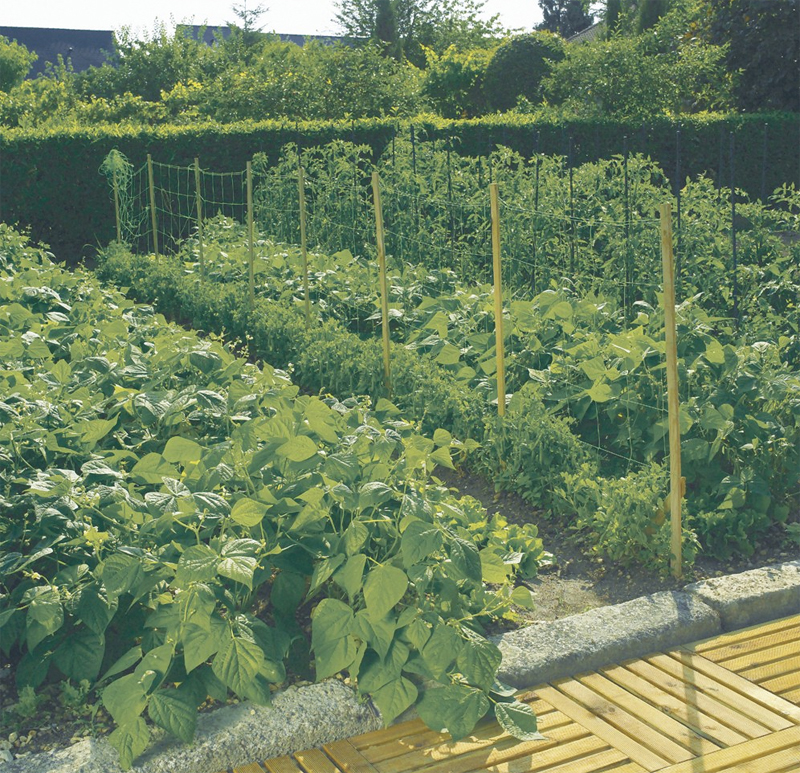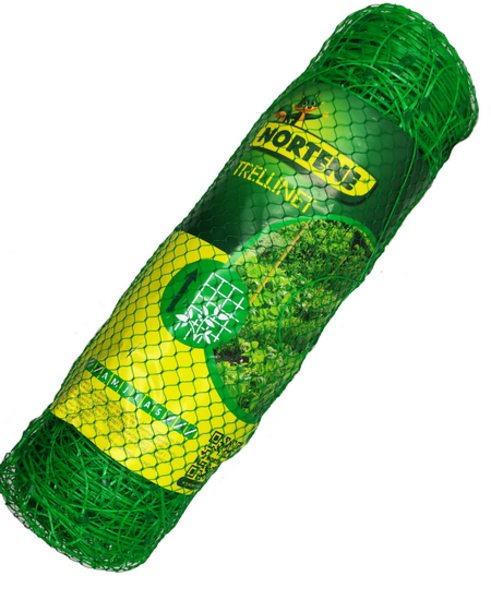Solid and durable, green.
Also used to create supports for climbing flowers and decorative vines.
Fastened to pegs at intervals of about 1-1.5 m to prevent sagging.
Cell size: 15 x 17 cm.

TRELLISED CUCUMBERS: A MODERN APPROACH.
The primary reasons for low cucumber yields are the increasing prevalence of powdery mildew (for which no fully reliable control measures currently exist) and the limited availability of resistant varieties and hybrids.
However, there is a solution: trellising. Traditional ground-level cultivation creates ideal conditions for powdery mildew development.
Infection Mechanism: Spores overwinter on soil surface debris, splashing onto the undersides of leaves—their primary target. Once foliage is infected, growers face an uphill battle. The disease spreads rapidly, forcing premature harvests. Typically, only 2–3 marketable pickings are possible; subsequent collections are merely salvage operations, with corresponding price drops.
Vertical Cultivation Advantages.
Trellising offers:
- Simplified plant management
- Improved fruit quality
- Optimized growing conditions
- Yields up to 100+ tons/ha in commercial production
Why Vertical?
Cucumbers are herbaceous vines native to India's humid forests, where they climb toward sunlight using tendrils. Trellising replicates this natural habit while providing critical benefits:
- Disease Reduction: Elevates plants above soilborne spores. Enhanced airflow and sunlight exposure minimize dew retention, slowing mildew spread.
- Spray Efficiency: Improved coverage of leaf undersides during treatments.
- Fruit Quality: Fewer misshapen fruits and soil-contact blemishes.
Labor increases (tying plants to wires/mesh, reattaching detached vines) is offset by higher productivity and extended harvest windows.
Economic Case.
Initial trellis costs (support posts, wires) are one-time investments lasting 5+ years. When amortized against 2–3x yield increases, the economics overwhelmingly favor vertical systems.
IMPLEMENTATION GUIDE.
Site Preparation:
- Test for plow pans; subsoil 10–15 cm below this layer to boost yields by 15–30%.
- Prioritize organic matter incorporation.
- Orient rows north-south to reduce midday sun stress.
- Limit row lengths to <100 m for practicality.
- Interrow spacing: 1.4–2.8 m (manual/machine access).
Support Systems.
Materials:
- Pine logs (min. 50 mm top diameter, 2.8 m length)
- Reinforced concrete posts (20+ year lifespan)
Installation:
- End posts: Set at 60–70° angles, 70–80 cm depth, anchored with wire stays or diagonal braces (≥45°).
- Intermediate posts: 35–40 mm diameter, 2.4 m length, 60 cm embedment.
- Spacing: ≤6 m between posts.
Trellis Options:
- Plastic mesh (5-year lifespan) stretched between upper/lower wires.
- Wire-only:
- Lower wire (2–2.5 mm): 15–20 cm height.
- Middle wire: 70–80 cm above lower.
- Top wire (3.5 mm): Load-bearing, atop posts.
Planting Strategy:
- Intercropping: Utilize alleys for bush beans or black-mulched strawberries (avoid tomato-associated rotations).
- Transplants > Direct Seeding:
- Grow in 10×10×10 cm peat pots or conical cell trays (5×5 cm in warm regions).
- Transplant at 1–3 true leaves, post-frost risk.
- Spacing: 10–20 cm (varies by cultivar). Aim for continuous (non-overlapping) leaf walls.
Ideal varieties: parthenocarpic gherkin hybrids for trellising (e.g., Dirigent, Adam, Dolomit).
Cucumber disease prevention.
For disease prevention, plants at the 2-3 leaf stage should be treated with one of the following copper-containing preparations:
• 90% wettable powder of copper oxychloride (2.4 g per 10 m² at 0.4% concentration);
• 1% Bordeaux mixture (10 g copper sulfate and 10-12 g lime per 1 liter of water). Application rate for strip treatment is 0.5 liters per 10 m².
When plants are infested by pests (spider mites, aphids), use "Kleshchevit", "Biotlin", "Fitoverm" or other systemic acaricides.
Against powdery mildew, spray plants with colloidal sulfur suspension (4-5 g per 1 liter of water).












